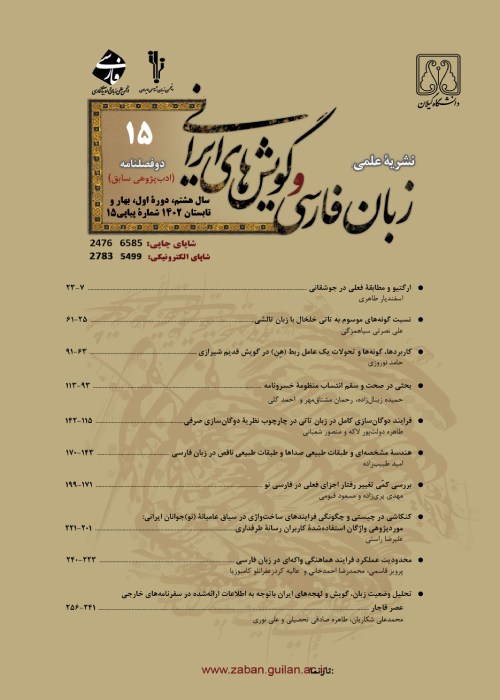The Semantic Frames of the Verb Xandæn in Persian
One of the most important issues in the field of semantics is polysemy occurring at different language levels. The purpose of the present study is to investigate the semantic frames of the verb xandæn and to present the different meanings of this verb in Persian based on the Frame Semantics Theory (1982) in cognitive approach. The methodology of this qualitative research is descriptive-analytic, and the studied corpus contains the prototypical and distinctive meanings of the Persian verb xandæn collected from Farhang-e Bozorg-e Soxan. In the mentioned book, fifteen distinctive meanings have been documented for this verb. The total samples used in the present research are taken from this book. The analysis of the research data revealed that the prototypical meaning of the verb xandæn is ‘reading’. Moreover, it was showed that, in addition to the prototypical meaning of "reading" as a semantic frame, xandæn illustrates five more semantic clusters, namely “mapping, comprehension, education, naming and metaphorical meaning,” which are regarded as semantic sub-frames of "perceptual-visual". In other words, all distinctive meanings fall under this particular semantic sub-frame. The research findings give a clear picture of the meanings of xandæn in Persian. Also, the explanations presented in this study can be useful in Persian language teaching and facilitate learning Persian for Persian language learners.
One of the most important issues in the field of semantics is polysemy occurring at different language levels.The purpose of the present study is to investigate the semantic frames of the verb xandæn and to present the different meanings of this verb in Persian based on the Frame Semantics Theory (1982) in cognitive approach.Frames are represented as the lexical units. In other words, lexical units are used to express mental concepts (i.e. frames) so that the semantic differences in a single general concept or a single frame are portrayed through different lexical units. In this regard, Fillmore has investigated the importance of studying the encyclopedic meaning and examining the semantic network of each word. He considers each template to be a single design of the experience that exists in human’s long-term memory. Therefore, it is not possible to understand the meaning of a word or a grammatical construction outside of its semantic frame. This frame consists of elements gathered around the experience. Each semantic frame is the knowledge needed to understand the meaning of a particular word or related words. In this article, among different lexical categories, the category of verb has been examined.
As the present study aims to investigate the polysemy of the verb xandan from the perspective of Frame Semantics model, in the following, the model which was first proposed by Fillmore (1982) will be introduced The model of Frame Semantics is based on the belief that words are empirical categories influenced by situations which are, in turn, shaped by background knowledge and experience. According to this idea, words are formed only through experiences and situations of human’s life, consequently the only possible way to realize how the semantic elements of speech are being served is to understand the experiences and the situations. With respect to the meaning of a word, Frame Semantics is an attempt to understand the motivations of a language community toward the production of a word category. Hence, this approach shows the meaning of a word by classifying these motives. Fillmore’s (1982) view of Frame Semantics is a study and research program in empirical semantics as well as providing a descriptive framework for explaining the results of such a study. He also believes that Frame Semantics provides both a specific way to deal with the meanings of words and a way to determine the principles of creating new words, as well furnishing conditions to add new meanings to words and to accumulate the meanings of the components of a text to understand the whole meaning. In his 1969 paper, Fillmore argues that cases such as agentive, experiencer, instrumental, patient, factive, locative, temporal, source, goal, companion, benefactor, and force are universal and possibly inherent concepts which are formed through the judgments humans make about the events taking place around them. Generally, there are two types of frames called “cognitive frames” and “interactive frames”. Interactive frames are concerned with how to conceptualize what happens between the speaker and the listener or between the writer and the reader. For further explanation, Fillmore describes the "scene" schema of the “transaction” field (Fillmore, 1977) and tries to prove that a large number of English verbs are semantically related in different ways through the same “scene” in the human mind. For example, in the field of transaction, there are certain elements such as ‘buyer’, ‘seller’, ‘goods’, and ‘money’, which through each a scene is highlighted alongside the transaction-related English verbs namely ‘sell’, ‘buy’, ‘pay’, ‘cost’ etc. while the other part shapes the scene background. According to the relationships that govern commercial exchange, the scenes of outside of the world portrays the buyer and the seller as giving money to the seller and giving goods to the byer in return. Interestingly, while expressing such a single scene in languages of the world bears a certain frame, the four mentioned elements express the same event in the form of a large set of sentences. Fillmore seeks to understand how these language patterns encode the outside world events.
The methodology of this qualitative research is descriptive-analytic, and the studied corpus contains the prototypical and distinctive meanings of the Persian verb xandæn collected from Farhang-e Bozorg-e Soxan. In this book, a myriad of distinctive meanings have been considered for xandæn. The total samples used in this article are taken from the mentioned book.
The research findings represent a clear picture of the meanings of the verb xandæn ‘reading’ in Persian.In this regard, the explanations presented in this study can be useful in Persian language teaching and can facilitate learning Persian for Persian language learners. Studying the fifteen distinct semantic frames in Persian for the verb xandæn ‘reading’ in Persian based on the findings of this article indicate that the analysis of this verb led to finding fifteen distinct semantic frames in Persian among which the meaning of ‘reading’ is considered as the prototypical meaning, which immediately comes to the mind of the Persian speakers. 5. Conclusions The main focus of this study was on the verb xandan in Persian. Analyzing the separate meanings of this verb based on Fillmore's frame semantics model (1982) in cognitive semantics, it was found that this verb bears the prototypical and primary meaning of ‘reading’. The results also showed that this verb, in addition to the prototypical meaning of ‘reading’ as a semantic frame, portrays five more semantic clusters, namely “mapping, comprehension, education, naming and metaphorical meaning,” which are regarded as semantic sub-frames of “perceptual-visual”. In other words, all distinctive meanings fall under this particular semantic sub-frame.
polysemy , Frame Semantics , xandæn , Persian
- حق عضویت دریافتی صرف حمایت از نشریات عضو و نگهداری، تکمیل و توسعه مگیران میشود.
- پرداخت حق اشتراک و دانلود مقالات اجازه بازنشر آن در سایر رسانههای چاپی و دیجیتال را به کاربر نمیدهد.



